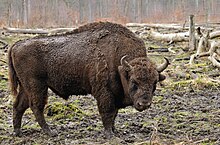Rewilding
Jump to navigation
Jump to search
Rewilding involves restoring native animals and plant species in large wilderness cores, with habitat corridors for wildlife movement, and recovery of large carnivores.
Quotes[edit]


- The rewilding of natural ecosystems that fascinates me is not an attempt to restore them to any prior state, but to permit ecological processes to resume.
- Rewilding, to me, is about resisting the urge to control nature and [instead] allowing it to find its own way. It involves reintroducing absent plants and animals (and in a few cases culling exotic species which cannot be contained by native wildlife), pulling down the fences, blocking the drainage ditches, but otherwise stepping back. At sea, it means excluding commercial fishing and other forms of exploitation. The ecosystems that result are best described not as wilderness, but as self-willed: governed not by human management but by their own processes.
- The straight-tusked elephant, related to the species that still lives in Asia today, persisted in Europe until around 40,000 years ago....If the evidence is as compelling as it seems, it suggests that this species dominated the temperate regions of Europe. Our ecosystems appear to be elephant-adapted.
- George Monbiot (2013). Feral: Rewilding the Land, Sea and Human Life, Penguin Books.
- Originally defined as a conservation method based on 'cores, corridors and carnivores,' the term [of rewilding] is now broadly understood as the repair or refurbishment of an ecosystem's functionality through the (re)introduction of selected species.
- The concept of rewilding was originally framed as a call for large, connected wilderness areas to support wide-ranging keystone species such as apex predators.
- Pettorelli, Durant & du Troit (eds.) (2019). Rewilding, Cambridge University Press.
- ...when it comes to preserving ecosystems, large is better than small, connected is better than isolated, and whole is better than fragmented.
- Caroline Fraser (2009). Rewilding the World: Dispatches from Conservation Revolution, Henry Holt and Company.
- Rewilding has also shown us that many of the areas that we consider pristine or well conserved (including many national parks) are actually deprived of many of their keystone species and therefore suffering varying levels of degradation.
- Hawkins, Convery, Carver & Beyers (eds.) (2023) Routledge Handbook of Rewilding, Routledge.
External links[edit]
- ↑ Vaughan, Adam (2014-05-21). "Return of the European Bison". The Guardian.
